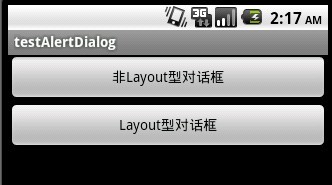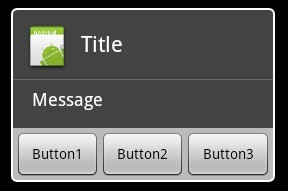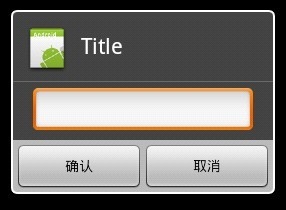Android入门之AlertDialog用法实例分析
本文实例讲述的是AlertDialog,这种对话框会经常遇到。AlertDialog跟WIN32开发中的Dialog不一样,AlertDialog是非阻塞的,而阻塞的对话框用的是PopupWindow。
先贴出该程序运行的截图:

main.xml的源码:
<?xml version="1.0" encoding="utf-8"?>
<LinearLayout xmlns:android="http://schemas.android.com/apk/res/android"
android:orientation="vertical"
android:layout_width="fill_parent"
android:layout_height="fill_parent"
>
<Button android:id="@+id/Button01" android:layout_height="wrap_content" android:text="非Layout型对话框" android:layout_width="fill_parent"></Button>
<Button android:id="@+id/Button02" android:layout_height="wrap_content" android:text="Layout型对话框" android:layout_width="fill_parent"></Button><View android:id="@+id/View01" android:layout_width="wrap_content" android:layout_height="wrap_content"></View>
</LinearLayout>
下图是非Layout型对话框,直接使用AlertDialog

下图是使用了Layout的对话框,可以自定义控件,实现更复杂的对话框

dialoglayout.xml的源码:
<?xml version="1.0" encoding="utf-8"?>
<LinearLayout xmlns:android="http://schemas.android.com/apk/res/android"
android:layout_width="fill_parent" android:layout_height="wrap_content"
android:orientation="vertical">
<EditText android:layout_height="wrap_content"
android:layout_width="fill_parent" android:layout_marginLeft="20dip"
android:layout_marginRight="20dip" android:textAppearance="?android:attr/textAppearanceMedium" android:id="@+id/edtInput"/>
</LinearLayout>
程序源码:
package com.testAlertDialog;
import android.app.Activity;
import android.app.AlertDialog;
import android.content.Context;
import android.content.DialogInterface;
import android.os.Bundle;
import android.view.Gravity;
import android.view.LayoutInflater;
import android.view.View;
import android.view.View.OnClickListener;
import android.widget.Button;
import android.widget.EditText;
import android.widget.PopupWindow;
public class testAlertDialog extends Activity {
Button btnShowDialog;
Button btnShowDialog_Layout;
/** Called when the activity is first created. */
@Override
public void onCreate(Bundle savedInstanceState) {
super.onCreate(savedInstanceState);
setContentView(R.layout.main);
//定义按钮
btnShowDialog=(Button)this.findViewById(R.id.Button01);
btnShowDialog.setOnClickListener(new ClickEvent());
btnShowDialog_Layout=(Button)this.findViewById(R.id.Button02);
btnShowDialog_Layout.setOnClickListener(new ClickEvent());
}
//统一处理按键事件
class ClickEvent implements OnClickListener{
@Override
public void onClick(View v) {
// TODO Auto-generated method stub
if(v==btnShowDialog)
showDialog(testAlertDialog.this);
else if(v==btnShowDialog_Layout)
showDialog_Layout(testAlertDialog.this);
}
}
//显示基本的AlertDialog
private void showDialog(Context context) {
AlertDialog.Builder builder = new AlertDialog.Builder(context);
builder.setIcon(R.drawable.icon);
builder.setTitle("Title");
builder.setMessage("Message");
builder.setPositiveButton("Button1",
new DialogInterface.OnClickListener() {
public void onClick(DialogInterface dialog, int whichButton) {
setTitle("点击了对话框上的Button1");
}
});
builder.setNeutralButton("Button2",
new DialogInterface.OnClickListener() {
public void onClick(DialogInterface dialog, int whichButton) {
setTitle("点击了对话框上的Button2");
}
});
builder.setNegativeButton("Button3",
new DialogInterface.OnClickListener() {
public void onClick(DialogInterface dialog, int whichButton) {
setTitle("点击了对话框上的Button3");
}
});
builder.show();
}
//显示基于Layout的AlertDialog
private void showDialog_Layout(Context context) {
LayoutInflater inflater = LayoutInflater.from(this);
final View textEntryView = inflater.inflate(
R.layout.dialoglayout, null);
final EditText edtInput=(EditText)textEntryView.findViewById(R.id.edtInput);
final AlertDialog.Builder builder = new AlertDialog.Builder(context);
builder.setCancelable(false);
builder.setIcon(R.drawable.icon);
builder.setTitle("Title");
builder.setView(textEntryView);
builder.setPositiveButton("确认",
new DialogInterface.OnClickListener() {
public void onClick(DialogInterface dialog, int whichButton) {
setTitle(edtInput.getText());
}
});
builder.setNegativeButton("取消",
new DialogInterface.OnClickListener() {
public void onClick(DialogInterface dialog, int whichButton) {
setTitle("");
}
});
builder.show();
}
}
您可能感兴趣的文章:Android中AlertDialog各种对话框的用法实例详解Android使用自定义alertdialog实现确认退出按钮Android中AlertDialog的六种创建方式Android AlertDialog自定义样式实现代码Android中阻止AlertDialog关闭实例代码Android仿IOS自定义AlertDialog提示框Android AlertDialog对话框用法示例Android使用AlertDialog实现的信息列表单选、多选对话框功能Android编程实现Dialog窗体监听的方法Android开发实现AlertDialog中View的控件设置监听功能分析
相关文章
Vala
2020-03-25
Urania
2021-08-05
Camille
2023-07-21
Ianthe
2023-07-21
Kohana
2023-07-21
Bambi
2023-07-21
Hanna
2023-07-21
Laila
2023-07-21
Hasana
2023-07-21
Jacinda
2023-07-21
Tanya
2023-07-21
Ipo
2023-07-21
Ophelia
2023-07-21
Mora
2023-07-21
Bella
2023-07-21
Jacuqeline
2023-07-21
Bonnie
2023-07-21
Hana
2023-07-21